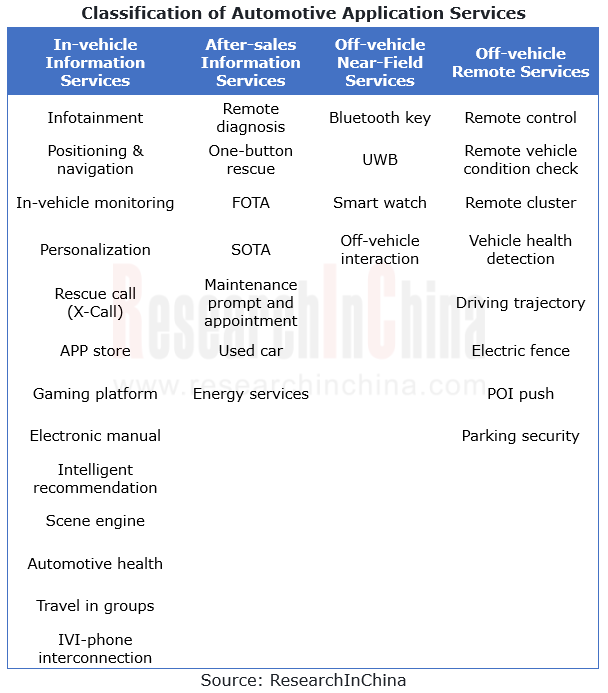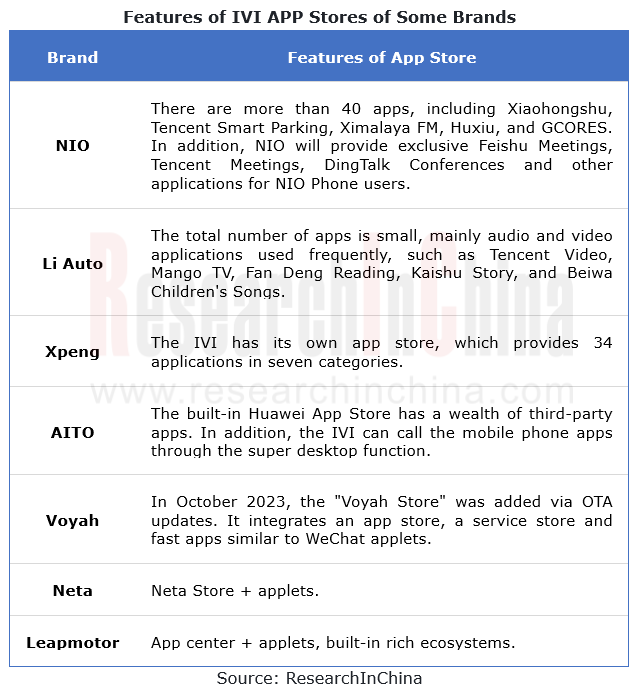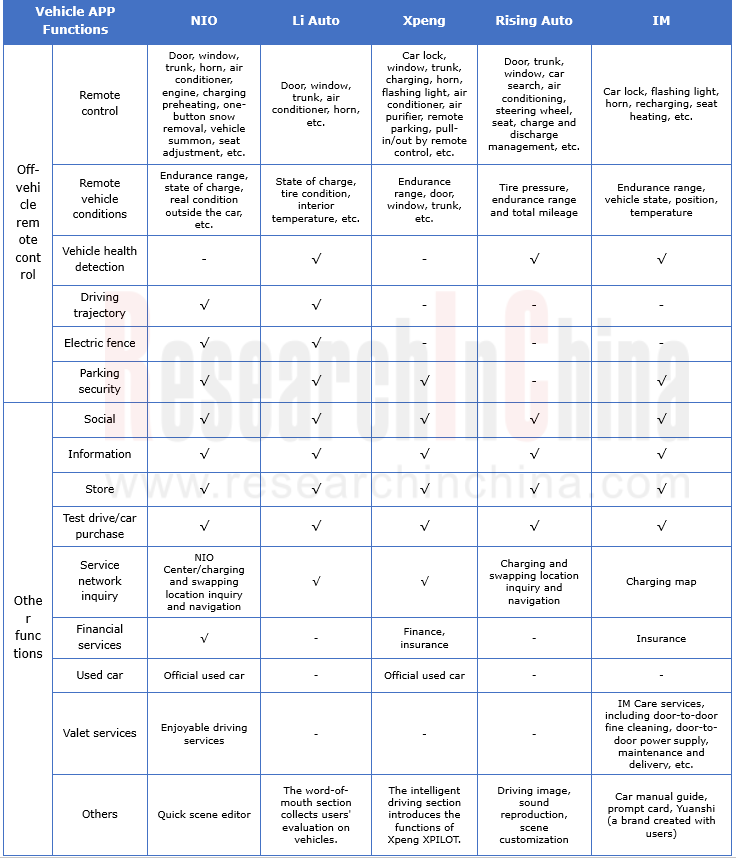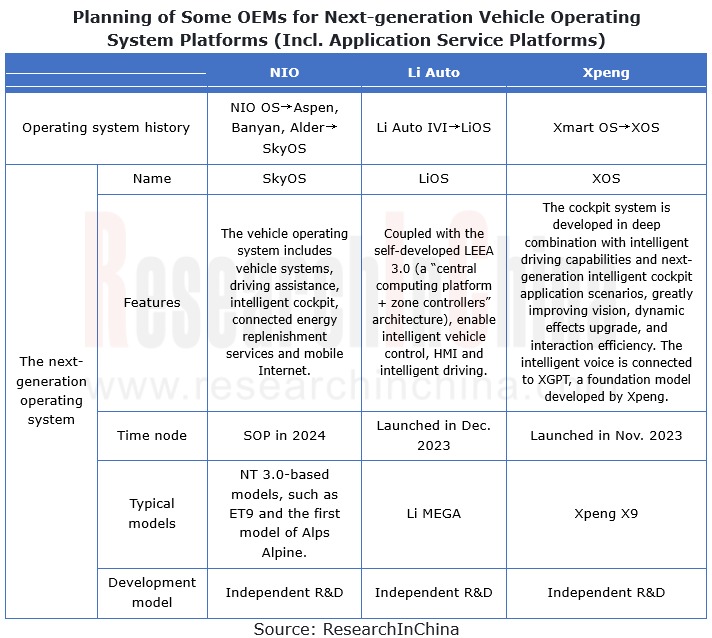Automotive Telematics Service Providers (TSP) and Application Services Research Report, 2023-2024
From January to September 2023, the penetration of telematics in passenger cars in China hit 77.6%, up 12.8 percentage points from the prior-year period. The rising penetration of telematics provides a market foundation for intelligent connected services, and consumers’ connection needs and usage habits take shape. Next how to provide diversified, personalized and intelligent application services using telematics big data will become the focus of major OEMs forging brand differentiation.
At present, China’s intelligent connected vehicle application services are mainly four scenario services: in-vehicle information services, after-sales information services, off-vehicle near-field services and off-vehicle remote services.
In-vehicle information services are mainly based on intelligent cockpit applications. In addition to conventional services such as infotainment, positioning, navigation, in-vehicle monitoring and rescue call, personalization, APP stores, vehicle gaming platforms, intelligent recommendations, scene engines, etc. have become hotspots of application services, which is accompanied by increasing big data applications in vehicles.
Centering on users’ needs for car usage and maintenance, after-sales information services provide remote diagnosis, one-button rescue, OTA updates, maintenance prompts and reservations, energy services for used cars and new energy vehicles, etc.
Off-vehicle near-field services are mainly enabled by near-field communications, such as digital keys like Bluetooth /UWB, smart watches, and off-vehicle interaction.
Off-vehicle remote services mainly use mobile phone APPs to remotely control vehicles, check vehicle conditions, detect vehicle status, etc.

First, IVI APP stores enhance the personalization and scalability of in-vehicle services.
With rich ecological applications, APP stores can not only enhance the personalized and entertaining experience for users, but also enables the scalability of the application ecosystem, for example, users can work in the vehicle using office and conference software. At this stage, Chinese brands like BYD, NIO, Xpeng and Li Auto are the first to install APP stores in their IVI systems. Their foreign peers are following suit.
In February 2023, The Driven, an Australian electric vehicle website, issued an article saying that Tesla may already be working on its own Apple-like app store that would enable car owners to download and install applications to their electric cars.
In March 2023, Volkswagen Group officially announced that it would bring a new app store to its multiple auto brands and car models. Users can enjoy a mass of third-party applications via the update.

Second, the deep integration of mobile phones and IVI will spur more application services.
Mobile phones offer the most contact points and the longest contact time in automotive application services, and have become a bridge connecting people with cars and other devices. Mobile phone APPs can not only be used for remote car control, but also provide social contact, test drive/car purchase services, financial services, valet services, and even customized scenes, car manual guide and user evaluation, becoming a carrier for OEMs to create full life cycle services for users.
APP Functions of Some Mobile Phone Brands

Note: √ means confirmed installation;
- means uninstallation or uncertain installation.
Source: ResearchInChina
At this stage, the special services offered by OEMs through mobile phone APPs mainly include:
1.Valet services
The enjoyable driving services of NIO are 7*24h customized services directly provided by NIO’s road service team according to users' demand. Using NIO APP, users can enjoy various valet services such as valet driving and accompanying, for example, accompanying the elderly to see a doctor and sending them to the hospital for physical examination, and accompanying children to do homework.
IM Care provides users with such services as door-to-door fine cleaning, door-to-door power supply, maintenance, and pick-up and delivery.
2. Feedback
Li Auto has set up a "word-of-mouth" section on its mobile phone APP, which enables users to evaluate vehicles in three dimensions: functions (appearance design, riding space, extended-range electric mode, chassis suspension, smart space and intelligent driving), services (after-sales service) and others (reasons for buying a car, satisfaction and expected improvements), thus creating a feedback channel for users.
3. Function introduction
Xpeng introduces the functions of Xpeng XPILOT to users via the intelligent driving section of the mobile phone APP. IM provides the manual guide for users via on the mobile phone APP.
4.Custom scenarios
NIO and Rising Auto set up scenario editors on their mobile phone APPs to enable users to add custom scenarios according to their preferences.
5. Brand co-creation
The Yuanshi Plan launched by IM encourages users to share mileage data, participate in interaction tasks and official co-creation activities on the APP, so as to enhance users' brand loyalty and achieve the effect of brand co-creation by way of issuing "original stones" (Yuanshi) and product redemption.
In addition, cross-terminal system applications such as HarmonyOS, and mobile phone vendors like OPPO, VIVO, Meizu and NIO Phone have entered IVI, bringing deeper integration of mobile phones and IVI. Cross-terminal data flow applications offer a bigger imaginable space to OEMs and suppliers, which may help to create more new services.
Third, the next-generation application service platform will build all-scenario service capabilities covering intelligent driving, cockpit and connectivity.
As E/E architectures tend to be centralized, automotive operating systems develop along the path of "IVI → cockpit → vehicle". In the era of vehicle operating systems, OEMs need to be based on SOA to realize cross-domain scheduling and functional integration among communication domain, cockpit domain and intelligent driving domain. There are two paths for OEMs to achieve cross-domain software integration: self-developing operating system platforms and application service platforms, represented by NIO, Xpeng and Li Auto; self-developing application service platforms but outsourcing operating system platforms to Neusoft, ThunderSoft and the like, represented by coventional automakers.
Therefore, emerging automakers such as NIO, Xpeng and Li Auto integrate the next-generation application service platforms with vehicle operating systems.
SkyOS, NIO’s next-generation operating system platform (including an application service platform), is an all-domain vehicle operating system, involving vehicle systems, driving assistance, intelligent cockpit, connected energy replenishment services and mobile Internet. It is applied to telematics, vehicle control, autonomous driving and digital cockpits.
LiOS, Li Auto’s next-generation operating system platform (including an application service platform), coupled with the self-developed LEEA 3.0 (a “central computing platform + zone controllers” architecture), combines intelligent driving domain, intelligent cockpit domain and vehicle control domain as a complete central domain.

New Energy Vehicle Cross-Domain (Electric Drive System and Powertrain Domain) Integration Trend Report 2025-2026
Electric Drive and Powertrain Domain Research: New technologies such as three-motor four-wheel drive, drive-brake integration, and corner modules are being rapidly installed in vehicles.
Electric dri...
Analysis on Desay SV and Joyson Electronic's Electrification, Connectivity, Intelligence and Sharing, 2025
Research on Desay SV and Joyson Electronic: Who is the No.1 Intelligent Supplier?
Both Desay SV and Joyson Electronic are leading domestic suppliers in automotive intelligence. "Analysis on Desay SV ...
OEMs and Tier 1 Suppliers' Cost Reduction and Efficiency Enhancement Strategy Analysis Report, 2025
ResearchInChina released the "OEMs and Tier 1 Suppliers' Cost Reduction and Efficiency Enhancement Strategy Analysis Report, 2025", summarizing hundreds of cost reduction strategies to provide referen...
Automotive Fixed Panoramic Sunroof and Smart Roof Research Report, 2025
With the intelligent application of car roofs as the core, this report systematically sorts out a series of new products such as fixed panoramic sunroof/openable sunroof, ceiling screen, roof ambient ...
Automotive-Grade Power Semiconductor and Module (SiC, GaN) Industry Research Report, 2025
SiC/GaN Research: Sales volume of 800V+ architecture-based vehicles will increase more than 10 times, and hybrid carbon (SiC+IGBT) power modules are rapidly being deployed in vehicles.
Sales volume o...
Cockpit Agent Engineering Research Report, 2025
Cockpit Agent Engineering Research: Breakthrough from Digital AI to Physical AI
Cockpit Agent Engineering Research Report, 2025 starts with the status quo of cockpit agents, summarizes the technical ...
Prospective Study on L3 Intelligent Driving Technology of OEMs and Tier 1 Suppliers, 2025
L3 Research: The Window of Opportunity Has Arrived - Eight Trends in L3 Layout of OEMs and Tier 1 Suppliers
Through in-depth research on 15 OEMs (including 8 Chinese and 7 foreign OEMs) and 9 Tier 1 ...
China Commercial Vehicle IoV and Intelligent Cockpit Industry Research Report 2025
Commercial Vehicle IoV and Cockpit Research: The Third Wave of Passenger Car/Commercial Vehicle Technology Integration Arrives, and T-Box Integrates e-Call and 15.6-inch for Vehicles
I. The third wav...
Intelligent Vehicle Electronic and Electrical Architecture (EEA) and Technology Supply Chain Construction Strategy Research Report, 2025
E/E Architecture Research: 24 OEMs Deploy Innovative Products from Platform Architectures to Technical Selling Points
According to statistics from ResearchInChina, 802,000 passenger cars with domain...
Research Report on Intelligent Vehicle Cross-Domain Integration Strategies and Innovative Function Scenarios, 2025
Cross-Domain Integration Strategy Research: Automakers' Competition Extends to Cross-Domain Innovative Function Scenarios such as Cockpit-Driving, Powertrain, and Chassis
Cross-domain integration of ...
China Autonomous Driving Data Closed Loop Research Report, 2025
Data Closed-Loop Research: Synthetic Data Accounts for Over 50%, Full-process Automated Toolchain Gradually Implemented
Key Points:From 2023 to 2025, the proportion of synthetic data increased from 2...
Automotive Glass and Smart Glass Research Report, 2025
Automotive Glass Report: Dimmable Glass Offers Active Mode, Penetration Rate Expected to Reach 10% by 2030
ResearchInChina releases the Automotive Glass and Smart Glass Research Report, 2025. This r...
Passenger Car Brake-by-Wire (BBW) Research Report, 2025
Brake-by-Wire: EHB to Be Installed in 12 Million Vehicles in 2025
1. EHB Have Been Installed in over 10 Million Vehicles, A Figure to Hit 12 Million in 2025.
In 2024, the brake-by-wire, Electro-Hydr...
Autonomous Driving Domain Controller and Central Computing Unit (CCU) Industry Report, 2025
Research on Autonomous Driving Domain Controllers: Monthly Penetration Rate Exceeded 30% for the First Time, and 700T+ Ultrahigh-compute Domain Controller Products Are Rapidly Installed in Vehicles
L...
China Automotive Lighting and Ambient Lighting System Research Report, 2025
Automotive Lighting System Research: In 2025H1, Autonomous Driving System (ADS) Marker Lamps Saw an 11-Fold Year-on-Year Growth and the Installation Rate of Automotive LED Lighting Approached 90...
Ecological Domain and Automotive Hardware Expansion Research Report, 2025
ResearchInChina has released the Ecological Domain and Automotive Hardware Expansion Research Report, 2025, which delves into the application of various automotive extended hardware, supplier ecologic...
Automotive Seating Innovation Technology Trend Research Report, 2025
Automotive Seating Research: With Popularization of Comfort Functions, How to Properly "Stack Functions" for Seating?
This report studies the status quo of seating technologies and functions in aspe...
Research Report on Chinese Suppliers’ Overseas Layout of Intelligent Driving, 2025
Research on Overseas Layout of Intelligent Driving: There Are Multiple Challenges in Overseas Layout, and Light-Asset Cooperation with Foreign Suppliers Emerges as the Optimal Solution at Present
20...